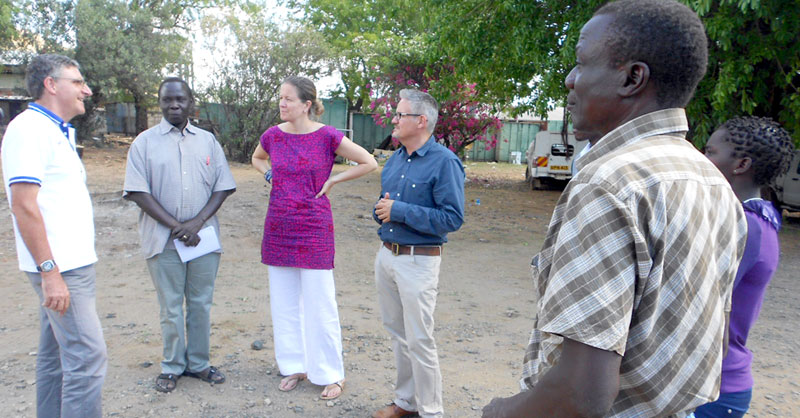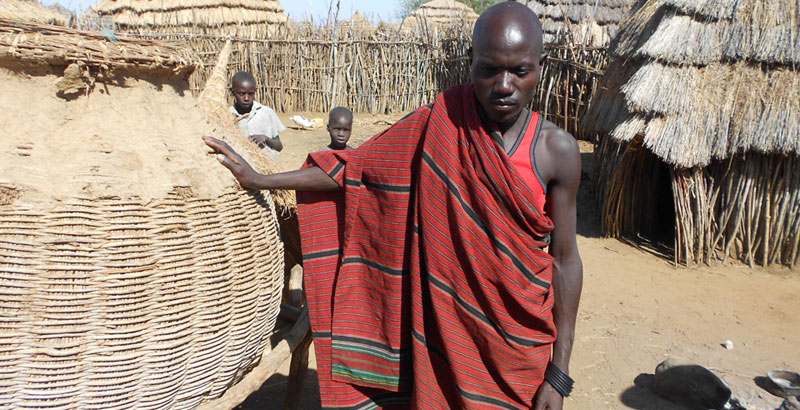human traffickingFeatures
Karamoja: When the silence of guns also means going to bed hungry
Esther Napeyok sits by the side of Moroto church looking on as the night approaches. From here she can hear hymns in her native language, Ngakarimojong, being rehearsed by the church choir in preparation for the next service. A chilly dry wind whistles through the green trees surrounding the cathedral, tossing in the air some dust and dry leaves. She slowly turns back to look at Mount Moroto, the giant of Moroto town who was once green and pretty but has over time gone grey. It is the end of another hot and dry day in Karamoja.
“This is home. My parents live here; my siblings. This is our home,” Napeyok says, her subdued voice revealing despair over things around her, yet she remains brave and proud to belong to one of the remotest, forgotten and most deprived tribes in Uganda, the Karimojong. They live in the north east of the country and their population is estimated at 1.4 million people.
By the time Napeyok was born in the 1980s, in Napak district, many of the Karimojong were infamous warriors. They had bows and arrows, and guns acquired in the 1970s during the anarchy of President Iddi Amin’s regime. They raided their neighbours in Kenya, Sudan and within Uganda especially to steal cattle. They waylaid vehicles and robbed merchandise and money. They raped and killed, creating an insurgency that would last decades.
A Karimojong baby was destined for a familiar role in society based on one’s sex. Girls were for the kitchen and garden with their mothers. Boys had to herd goats, sheep and cows as soon as their legs could firmly carry them. You also had a chance to become a warrior as you grew up, if you were a boy.
As her age mates went about their routines, Napeyok was between 1993 and 1999 attending school at Moroto Municipal Primary School. She later moved south, to Iganga district for higher education but would still return home for holidays. Her parents lived in Moroto town, had been to school and they owned no animals, factors Napeyok thinks were key to her own education.
“What we feared were ambushes by cattle rustlers. When they were intercepted they were frustrated. It was quite tense. You would want to come home but when you think about it you are like ‘Oh My God!’ Every time you were on the road you were filled with fear. But we still moved. This was our home,” Napeyok says.
Karamoja has since moved on, arguably slowly. In 2001 the Ugandan government peacefully and forcefully started to disarm Karamoja, recovering over 30,000 guns by 2013, according to press reports. Since 2003 a government programme, the Northern Uganda Social Action Fund (NUSAF), funded by the World Bank, has been building schools, health units, water sources and establishing income generating activities for the locals among others – some $233.5m was spent between 2003 and 2015 and another $130m is to be spent between 2015 and 2020. Hundreds of nongovernmental organisations (NGOs) are in Karamoja apparently to help uplift people’s livelihoods there.
By 2010 peace could be felt in Karamoja. Napeyok, now a community development worker for Moroto District Local Government, can move around without fear. But this peace is just the withdrawal of illegal guns from the Karimojong. People are starving!
The Ministry of Agriculture Animal Industry and Fisheries (MAAIF) in February declared the region food insecure, with up to 65 percent of the population only having access to one or half a meal a day. There have not been sufficient rains for long so food can’t grow well. There is neither enough pasture nor water for the animals. The Karimojong have been forced to shift their cows, or desperately kill them and dry the carcasses to preserve them as food.
Kaipetar village, in Acecer Sub County, is just about 20 kilometres east of Moroto town. The sight of men hunched under trees at nine O’clock in the morning, looking haggard from effects of starvation and cheap potent gin, and miserably holding on to their sticks, gives one a hint of the price the Karimojong have to pay for a life without guns or water – they are paying with their lives.
“There is huge social transformation. Through disarmament changes happened. Because cattle rustling is no longer a practice the Karimong don’t have as much cattle as they had before. Men are looking for different ways of livelihoods. Women were always engaged in agriculture on a smaller scale but now with it becoming more dominant women are taking on this bigger burden of agriculture because men were traditionally not involved,” says Dr. Liza Debevec, a social anthropologist with the International Water Management Institute (IWMI).
As the Karimojong try to come to terms with social changes, from warrior-nomadic to kind of a more settled lifestyle, they also have to concurrently cope with the effects of climatic changes. Most of Karamoja receives below 800mm of rain per year, but this, little as it is, has also become irregular and unpredictable over the years.

Moroto Diocese Bishop Damiano Guzzetti (l) and Karitas’s Thomas Loquang (2nd left) speak to IWMI researchers Dr. Liza Debevec (m) and Dr. Alan Nicol in March 2017 at the church. Looking on are other guests from the region.
“It is four years we don’t have regular rains. People get discouraged from farming,” says Bishop Damiano Guzzetti, the Bishop of Moroto Diocese. The diocese covers the districts of Moroto, Napak, Nakapiripiriti and Amudat.
“For the last two years we have had a challenge with some farmers getting zero harvest. The drought has become worse,” adds Thomas Loquang, Executive Director Karitus Moroto. Karitas is the development arm of the Catholic Church.
Outside the Manyata, a well knitted homestead for the Karimojong, the kids will grin at the sight of a camera pointed at them. But it is midday and in the kitchen there is no sign of fire – so inside the manyata the mood is somber. Even the meanest or most ethical journalist would part with a few shillings for the interviewees’ family to have the next meal.
“We are starving so much because there is no rain. Even charcoal burning is not helping us. It is instead making us more tired and hungrier. When you take it to Moroto town they can give you Shs. 4000 for your sack, yet a can of flour costs Shs 6,000,” says Regina Nakiru, Chairperson Simon Village, Acerer Sub County.
“My mum tries to plant some sorghum every year. Previously the yields were good but today the seeds may even not come out of the soil. She planted three acres last year and got less than ten sacks – you can imagine after using a tractor, paying for labour…” Napeyok says.
Bishop Guzzetti first came to Karamoja in 1986. And from 1995 he has been working here. Now that there is peace, he says, “This is the right time to introduce the right things. Give people direction.” But on the ground, Guzzetti is not contented with what he sees.
“The efforts put on Karamoja have been endless. Resources have been poured here but with very little results. May be the methodology has to change,” he adds. To that, Napeyok has an idea – one that the elite planners could probably be ignoring, the real fabric of a Karimojong’s culture and economics, livestock.
“Government is trying to put a lot of money into farming; buying seeds, but you forget that this is a semi arid area. Animals have proved that they work better here,” she says. “It is the only thing that could support us but it has been ignored. I have been to Turkana. When animals have water they can eat anything dry and survive. We have a lot of rain but for a short time. We should harvest it and it takes us through the year.”
“It is difficult to keep kids in school when they are still nomadic. This lifestyle is forced because of lack of water. When there is water you keep the animals near but when you don’t have water you have to drive the animals to where there is water,” Napeyok adds.
There are only two big dams in Karamoja which can guarantee water for animals during dry spells, Kakicumet in Napak district and Kobebe in Moroto, but Karamoja has seven districts. The government has recently dug more dams and valley tanks, but these have been criticised as being small and drying up easily.
Until a viable solution is found for Karamoja’s social-economic challenges, the population will continue to migrate, or desperately survive on nature, cutting down trees for commercial charcoal and firewood production, thus making an already arid environment worse.
Comments



















